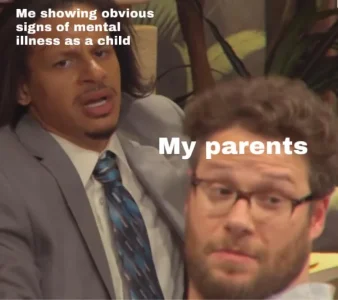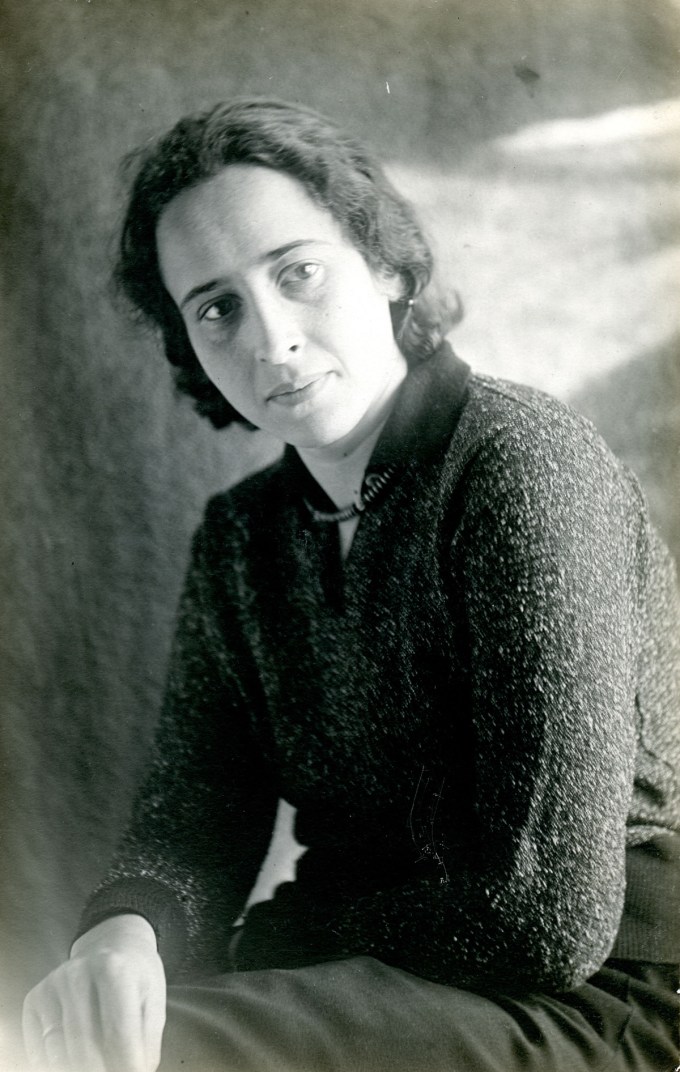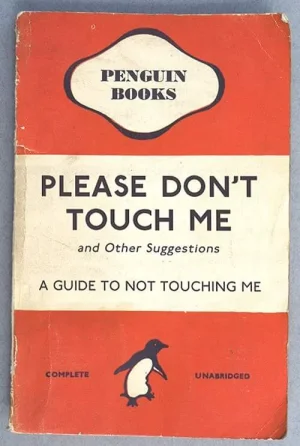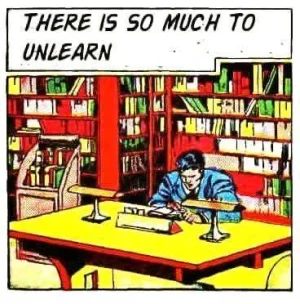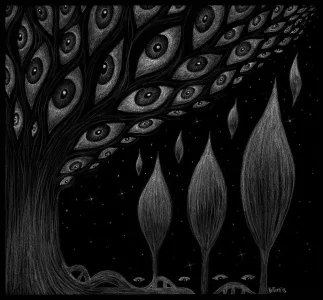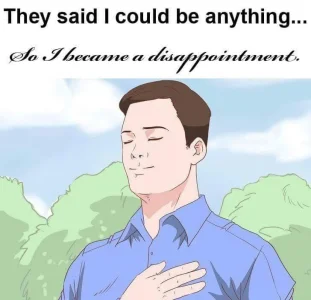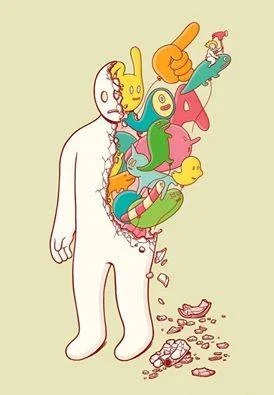You are using an out of date browser. It may not display this or other websites correctly.
You should upgrade or use an alternative browser.
You should upgrade or use an alternative browser.
Merkabah
- Thread starter Skarekrow
- Start date
More options
Who Replied?Skarekrow
~~DEVIL~~
- MBTI
- Ni-INFJ-A
- Enneagram
- Warlock
The Banality of Evil:
Hannah Arendt on the Normalization of
Human Wickedness and Our Only Effective Antidote to It
“Under conditions of terror most people will comply but some people will not…
No more is required, and no more can reasonably be asked,
for this planet to remain a place fit for human habitation.”
BY MARIA POPOVA

But modern life is no fairy tale and one of its most disorienting perplexities is that evil isn’t always as easily recognizable as a Grimm stepmother.
Maya Angelou captured this in her 1982 conversation with Bill Moyers about courage and facing evil, in which she observed:
“Throughout our nervous history, we have constructed pyramidic towers of evil, ofttimes in the name of good.”
Joseph Brodsky echoed the sentiment five years later in his spectacular speech on our greatest antidote to evil:
“What we regard as Evil is capable of a fairly ubiquitous presence if only because it tends to appear in the guise of good.”
A core cause of this perplexity lies in the fact that while acts of evil can mushroom into monumental tragedies, the individual human perpetrators of those acts are often marked not with the grandiosity of the demonic but with absolute mundanity.
This was the revolutionary and, like every revolutionary idea, at the time controversial point that Hannah Arendt (October 14, 1906–December 4, 1975) made in 1962, when The New Yorker commissioned her, a Jew of who had narrowly escaped from Nazi Germany herself, to travel to Jerusalem and report on the trial of Adolf Eichmann — one of the chief architects of the Holocaust.
In 1963, her writings about the trial were published as Eichmann in Jerusalem: A Report on the Banality of Evil(public library) — a sobering reflection on “the lesson that this long course in human wickedness had taught us — the lesson of the fearsome, word-and-thought-defying banality of evil.”
A decade after Arendt established herself as a formidable thinker with her incisive inquiry into how totalitarian tyrants take hold of a people, she writes:
"The essence of totalitarian government, and perhaps the nature of every bureaucracy, is to make functionaries and mere cogs in the administrative machinery out of men, and thus to dehumanize them."
It is through this lens of bureaucracy (which she calls “the rule of Nobody”) as a weapon of totalitarianism that Arendt arrives at her notion of “the banality of evil” — a banality reflected in Eichmann himself, who embodied “the dilemma between the unspeakable horror of the deeds and the undeniable ludicrousness of the man who perpetrated them.”
In a passage that applies to Donald Trump with astonishing accuracy — except the part about lying, of course; that aspect Arendt addressed with equal prescience elsewhere — she describes Eichmann:
"What he said was always the same, expressed in the same words.
The longer one listened to him, the more obvious it became that his inability to speak was closely connected with an inability to think, namely, to think from the standpoint of somebody else.
No communication was possible with him, not because he lied but because he was surrounded by the most reliable of all safeguards against the words and the presence of others, and hence against reality as such."
The Nazis, Arendt argues, furnished this deliberate disconnect from reality with what she calls “holes of oblivion.” (Today, we call them “alternative facts.”) In a searing testament to the power of speaking up, she considers what the story of the Holocaust — a story irrepressibly told by its survivors — has taught us:
"The holes of oblivion do not exist. Nothing human is that perfect, and there are simply too many people in the world to make oblivion possible. One man will always be left alive to tell the story."
[…]
"The lesson of such stories is simple and within everybody’s grasp.
Politically speaking, it is that under conditions of terror most people will comply but some people will not, just as the lesson of the countries to which the Final Solution was proposed is that “it could happen” in most places but it did not happen everywhere.
Humanly speaking, no more is required, and no more can reasonably be asked, for this planet to remain a place fit for human habitation."
Arendt took great care to differentiate between the banal and the commonplace, but some reviewers — as those pre-bent on a reflexive rebuttal are always apt to do — accused her of suggesting that the atrocity of the Holocaust had been commonplace, which of course was the very opposite of her point.
Among those who misunderstood her notion of the “banality” of evil to mean a trivialization of the outcome of evil rather than an insight into the commonplace motives of its perpetrators was the scholar Gerhard Scholem, with whom Arendt had corresponded warmly for decades.
At the end of a six-page letter to Scholem from early December of 1964, she crystallizes her point and dispels all grounds for confusion with the elegant precision of her rhetoric:
"You are quite right, I changed my mind and do no longer speak of “radical evil.” … It is indeed my opinion now that evil is never “radical,” that it is only extreme, and that it possesses neither depth nor any demonic dimension.
It can overgrow and lay waste the whole world precisely because it spreads like a fungus on the surface.
It is “thought-defying,” as I said, because thought tries to reach some depth, to go to the roots, and the moment it concerns itself with evil, it is frustrated because there is nothing.
That is its “banality.”
Only the good has depth that can be radical."
Eichmann in Jerusalem remains, unfortunately, an increasingly relevant masterwork as we face a world seized by banal tyrants capable of perpetrating enormous evil with their small hands.
But perhaps John Steinbeck put it best in his superb letter written months before Arendt arrived in New York as a refugee from Nazi Germany: “All the goodness and the heroisms will rise up again, then be cut down again and rise up. It isn’t that the evil thing wins — it never will — but that it doesn’t die.”
Complement it with Dostoyevsky on why there are no bad people and Mary McCarthy — Arendt’s longtime friend and correspondent — on how we decide whether evil is forgivable, then revisit Arendt on lying in politics, the meaning of “refugee,” how tyrants use isolation as a weapon of oppression, and the crucial difference between truth and meaning.
Last edited:
Skarekrow
~~DEVIL~~
- MBTI
- Ni-INFJ-A
- Enneagram
- Warlock
Fantastic!
Yale researchers have figured out how to catch and save Schrödinger's famous cat, the symbol of quantum superposition and unpredictability, by anticipating its jumps and acting in real time to save it from proverbial doom.
In the process, they overturn years of cornerstone dogma in quantum physics.
The discovery enables researchers to set up an early warning system for imminent jumps of artificial atoms containing quantum information.
A study announcing the discovery appears in the June 3 online edition of the journal Nature.
Schrödinger's cat is a well-known paradox used to illustrate the concept of superposition—the ability for two opposite states to exist simultaneously—and unpredictability in quantum physics.
The idea is that a cat is placed in a sealed box with a radioactive source and a poison that will be triggered if an atom of the radioactive substance decays.
The superposition theory of quantum physics suggests that until someone opens the box, the cat is both alive and dead, a superposition of states. Opening the box to observe the cat causes it to abruptly change its quantum state randomly, forcing it to be either dead or alive.
The quantum jump is the discrete (non-continuous) and random change in the state when it is observed.
The experiment, performed in the lab of Yale professor Michel Devoret and proposed by lead author Zlatko Minev, peers into the actual workings of a quantum jump for the first time.
The results reveal a surprising finding that contradicts Danish physicist Niels Bohr's established view—the jumps are neither abrupt nor as random as previously thought.
For a tiny object such as an electron, molecule, or an artificial atom containing quantum information (known as a qubit), a quantum jump is the sudden transition from one of its discrete energy states to another.
In developing quantum computers, researchers crucially must deal with the jumps of the qubits, which are the manifestations of errors in calculations.
The enigmatic quantum jumps were theorized by Bohr a century ago, but not observed until the 1980s, in atoms.
"These jumps occur every time we measure a qubit," said Devoret, the F.W. Beinecke Professor of Applied Physics and Physics at Yale and member of the Yale Quantum Institute. "Quantum jumps are known to be unpredictable in the long run.”
"Despite that," added Minev, "We wanted to know if it would be possible to get an advance warning signal that a jump is about to occur imminently."
Minev noted that the experiment was inspired by a theoretical prediction by professor Howard Carmichael of the University of Auckland, a pioneer of quantum trajectory theory and a co-author of the study.
In addition to its fundamental impact, the discovery is a potential major advance in understanding and controlling quantum information.
Researchers say reliably managing quantum data and correcting errors as they occur is a key challenge in the development of fully useful quantum computers.
The Yale team used a special approach to indirectly monitor a superconducting artificial atom, with three microwave generators irradiating the atom enclosed in a 3-D cavity made of aluminum.
The doubly indirect monitoring method, developed by Minev for superconducting circuits, allows the researchers to observe the atom with unprecedented efficiency.
Microwave radiation stirs the artificial atom as it is simultaneously being observed, resulting in quantum jumps.
The tiny quantum signal of these jumps can be amplified without loss to room temperature.
Here, their signal can be monitored in real time.
This enabled the researchers to see a sudden absence of detection photons (photons emitted by an ancillary state of the atom excited by the microwaves); this tiny absence is the advance warning of a quantum jump.
"The beautiful effect displayed by this experiment is the increase of coherence during the jump, despite its observation," said Devoret. Added Minev, "You can leverage this to not only catch the jump, but also reverse it."
This is a crucial point, the researchers said.
While quantum jumps appear discrete and random in the long run, reversing a quantum jump means the evolution of the quantum state possesses, in part, a deterministic and not random character; the jump always occurs in the same, predictable manner from its random starting point.
"Quantum jumps of an atom are somewhat analogous to the eruption of a volcano," Minev said. "They are completely unpredictable in the long term. Nonetheless, with the correct monitoring we can with certainty detect an advance warning of an imminent disaster and act on it before it has occurred.
More information: To catch and reverse a quantum jump mid-flight, Nature (2019). DOI: 10.1038/s41586-019-1287-z , https://www.nature.com/articles/s41586-019-1287-z
Journal information: Nature
Physicists can predict the jumps of Schrodinger's cat (and finally save it)
by Yale University
https://phys.org/news/2019-06-physicists-schrodinger-cat.html

Yale researchers have found a way to catch and save Schrödinger's famous cat, the symbol of quantum superposition and unpredictability.
by Yale University
https://phys.org/news/2019-06-physicists-schrodinger-cat.html

Yale researchers have found a way to catch and save Schrödinger's famous cat, the symbol of quantum superposition and unpredictability.
Yale researchers have figured out how to catch and save Schrödinger's famous cat, the symbol of quantum superposition and unpredictability, by anticipating its jumps and acting in real time to save it from proverbial doom.
In the process, they overturn years of cornerstone dogma in quantum physics.
The discovery enables researchers to set up an early warning system for imminent jumps of artificial atoms containing quantum information.
A study announcing the discovery appears in the June 3 online edition of the journal Nature.
Schrödinger's cat is a well-known paradox used to illustrate the concept of superposition—the ability for two opposite states to exist simultaneously—and unpredictability in quantum physics.
The idea is that a cat is placed in a sealed box with a radioactive source and a poison that will be triggered if an atom of the radioactive substance decays.
The superposition theory of quantum physics suggests that until someone opens the box, the cat is both alive and dead, a superposition of states. Opening the box to observe the cat causes it to abruptly change its quantum state randomly, forcing it to be either dead or alive.
The quantum jump is the discrete (non-continuous) and random change in the state when it is observed.
The experiment, performed in the lab of Yale professor Michel Devoret and proposed by lead author Zlatko Minev, peers into the actual workings of a quantum jump for the first time.
The results reveal a surprising finding that contradicts Danish physicist Niels Bohr's established view—the jumps are neither abrupt nor as random as previously thought.
For a tiny object such as an electron, molecule, or an artificial atom containing quantum information (known as a qubit), a quantum jump is the sudden transition from one of its discrete energy states to another.
In developing quantum computers, researchers crucially must deal with the jumps of the qubits, which are the manifestations of errors in calculations.
The enigmatic quantum jumps were theorized by Bohr a century ago, but not observed until the 1980s, in atoms.
"These jumps occur every time we measure a qubit," said Devoret, the F.W. Beinecke Professor of Applied Physics and Physics at Yale and member of the Yale Quantum Institute. "Quantum jumps are known to be unpredictable in the long run.”
"Despite that," added Minev, "We wanted to know if it would be possible to get an advance warning signal that a jump is about to occur imminently."
Minev noted that the experiment was inspired by a theoretical prediction by professor Howard Carmichael of the University of Auckland, a pioneer of quantum trajectory theory and a co-author of the study.
In addition to its fundamental impact, the discovery is a potential major advance in understanding and controlling quantum information.
Researchers say reliably managing quantum data and correcting errors as they occur is a key challenge in the development of fully useful quantum computers.
The Yale team used a special approach to indirectly monitor a superconducting artificial atom, with three microwave generators irradiating the atom enclosed in a 3-D cavity made of aluminum.
The doubly indirect monitoring method, developed by Minev for superconducting circuits, allows the researchers to observe the atom with unprecedented efficiency.
Microwave radiation stirs the artificial atom as it is simultaneously being observed, resulting in quantum jumps.
The tiny quantum signal of these jumps can be amplified without loss to room temperature.
Here, their signal can be monitored in real time.
This enabled the researchers to see a sudden absence of detection photons (photons emitted by an ancillary state of the atom excited by the microwaves); this tiny absence is the advance warning of a quantum jump.
"The beautiful effect displayed by this experiment is the increase of coherence during the jump, despite its observation," said Devoret. Added Minev, "You can leverage this to not only catch the jump, but also reverse it."
This is a crucial point, the researchers said.
While quantum jumps appear discrete and random in the long run, reversing a quantum jump means the evolution of the quantum state possesses, in part, a deterministic and not random character; the jump always occurs in the same, predictable manner from its random starting point.
"Quantum jumps of an atom are somewhat analogous to the eruption of a volcano," Minev said. "They are completely unpredictable in the long term. Nonetheless, with the correct monitoring we can with certainty detect an advance warning of an imminent disaster and act on it before it has occurred.
More information: To catch and reverse a quantum jump mid-flight, Nature (2019). DOI: 10.1038/s41586-019-1287-z , https://www.nature.com/articles/s41586-019-1287-z
Journal information: Nature
Skarekrow
~~DEVIL~~
- MBTI
- Ni-INFJ-A
- Enneagram
- Warlock
I love this type of science!

Enjoy!
Users of psychedelic substances, from traditional shamans to modern-day therapy patients and recreational users, have often reported ESP experiences occurring in the drug-state.
Parapsychologists, keen to discover whether this altered state of consciousness might prove a reliable way to induce clairvoyance and telepathy, carried out a number surveys and experimental studies before the 1960s, when such research was brought to an end by the virtual global ban on psychedelics.
However, the restrictions on such research are gradually easing, opening a prospect of the relationship between psi and psychedelics being better understood.
Definition
According to Grinspoon and Bakalar, a psychedelic substance is 'one which, without causing physical addiction, craving, major physiological disturbances, delirium, disorientation, or amnesia, more or less reliably produces thought, mood, and perceptual changes otherwise rarely experienced except in dreams, contemplative and religious exaltation, flashes of vivid involuntary memory, and acute psychoses.'1
Field Reports of Intentional and Spontaneous Psi Phenomena
Archaeological evidence suggests psychoactive plants have been ingested the world over for millennia,2 and there are many examples in the literature of anthropology and ethnobotany of this leading to the appearance of ostensible psi phenomena3 - despite reservations on the part of anthropologists against reporting them.4 Reports of paranormal experiences in this context became more frequent following the discovery of psychedelic compounds by the academic community, and their popularization by the novelist Aldous Huxley5 and others. This attracted the attention of parapsychologists, who embarked on research of psi in relation to psychedelics, primarily from the 1950s and 1960s6. JB Rhine, the founder of parapsychology as an experimental science, ran informal psychedelic sessions in 1961 in collaboration with the then Harvard psychologists Timothy Leary and Richard Alpert,7 although the sessions apparently generated too much spontaneous laughter for anyone to credibly test for anything.8
Several other parapsychologists have reported personal ESP experiences with the use of psychedelics.9 Krippner’s apparent precognitive vision of President Kennedy’s assassination while on psilocybin a year before serves as an example.10 Similar reports of ESP being experienced by consciousness researchers, chemists, anthropologists and psychonauts can also be found elsewhere in the literature.11
There are surprisingly few published psychiatric inpatient reports relating to psychedelics and paranormal experience.12 This may be due to the lack of spontaneous phenomena within the psychiatric population, or to the medicalization within psychiatry of paranormal experiences as ‘delusions’ or ‘hallucinations’. Indeed, Mogar noted that early psychoanalytic and behaviourist researchers using LSD were prejudiced against ESP phenomena.13 Yet one study, a psychiatric-interview survey with users of LSD, 14 reported precognitive experiences as one of the symptoms of the LSD flashback phenomena, now referred to as ‘hallucinogen persisting perception disorder’.15
On the other hand, many accounts of paranormal experiences with psychoactive drugs can be found in the field of psychedelic-assisted psychotherapy, from therapists who write about their work in detail, and these tend to occur with greater frequency than in non-psychedelic therapy16. The psychiatrist Stanislav Grof – who is generally credited with the greatest expertise in this field, having conducted more than 4,000 psychedelic therapy sessions over a two decade period – claimed to have observed patients experiencing ESP - particularly precognition and accurate remote viewing – on a daily basis. 17 18 The occurrence of extraordinary coincidences, or synchronicities, was the most frequent type of experience but, curiously, these occurred only among those clients who experienced transpersonal breakthroughs within the psychedelic session.19
A wealth of reports attests to the spontaneous occurrence of ostensible psi phenomena with the use of psychedelic substances, but such experiences are not necessarily genuine psi events. Aside from the usual arguments for and against spontaneous phenomena as evidence for the paranormal,20 21 the fact that respondents had consumed a vision-inducing substance may be considered reason to question the accuracy of their perception and the interpretation of their experiences – at least for cases that are not substantiated by evidence or independent observers. Nevertheless, Shanon22 pointed out that the usual definitions of hallucination in the psychological literature fail to adequately encompass the diverse and complex nature of experiences that occur with psychedelics, nor can assumptions be made about the ontology (the reality) of such psychedelic-induced visions. Indeed, it is common for people who have had ostensibly paranormal psychedelic experiences to emphasise how real they felt, more real even than ordinary waking experience.23Empirical research is needed to validate these claims.
Surveys of Paranormal Belief and Experience in Relation to Drug Use
Two trends can quickly be perceived in the research. First, virtually all of the 16 surveys reviewed were published since the 1970s, following the ban on the use of psychoactive drugs that led to an end to research with humans (although this research is now slowly resuming). Second, most of the surveys primarily focused on paranormal experiences (nine surveys) and/or belief (seven surveys); they also tended to record drug use information as one of many possible co-variables (ten surveys), often omitting to distinguish among the different substances. Only six studies specifically approached users of psychoactive substances as the target sample.24
The findings from the survey research indicate a small but consistent - and typically significant - relationship (r = .16 to .25) between paranormal belief and drug use, although its size was more pronounced among marijuana users in one study.25 Furthermore, these studies support the hypothesis that psychedelics can induce some paranormal experiences, although the arguments that are advanced for and against the genuineness of field reports also prevail here. 26 Of the reviewed surveys, correlations between the occurrence of paranormal experiences (including psi and mystical experiences) and the use of all drugs (excluding prescription drugs) ranged from r = .13 to .46, and were typically significant. In addition, or alternatively, those reporting ESP and anomalous or paranormal experiences were found to be significantly more likely to use psychedelics. One study recorded the same finding for recurrent spontaneous psychokinesis (also known as poltergeist phenomena), although only tentatively.27
Of those reporting the use of psychedelics, between 18-83% reported ESP experiences – most commonly telepathy but also precognition – actually occurring during drug use, with heavier users reporting more experiences where specified. Yet, conversely, the occurrence of psychokinesis during drug use was only reported to occur by between 13-22% of those using psychedelics.28
Where specified, the relationship with paranormal experiences, belief in the paranormal, transliminality, and tolerance of ambiguity is much reduced with cocaine, heroin, and alcohol, compared to psychedelics, perhaps reflecting Metzner’s classification of these former substances as consciousness-contracting drugs.29The same is also true for the negative relationship with the fear of psi and use of psychedelics, which is not apparent with heroin and actually reversed with alcohol, although replication and analyses for specific classes of drugs is needed to confirm this.30
Correlations between self-reports of cannabis use and ‘thought transmission’ in psychiatric research are apparent, often indirectly, though telepathy experiences are also more widely reported in the apparent absence of pathology, with or without cannabis. Most of the surveys failed to adequately identify which substances lead to which experiences, although a switch to such taxonomic research is now evident. 31Substances particularly favourable to the experience of telepathy were found to be cannabis, MDMA and DXM. No one substance was particularly generative of precognitive experiences, and possible candidates for clairvoyance were cannabis, LSD, and psilocybin. As yet no research has explored both state and trait personality dimensions in relation to substance-induced psi experiences, although such research is encouraged.32 33
Experimental Psi Research with Psychedelics
The earliest parapsychology experiments with psychoactive substances, published between 1943 and 1961, were conducted with simple stimulants and depressants such as caffeine, amphetamine, alcohol, amytal, and quinal-barbitone, with mixed results.34
So far there have been only 18 published papers, comprising 23 separate experiments, into the efficacy of psychedelics for inducing ESP, primarily with LSD or psilocybin, but also with mescaline, cannabis, Amanita muscaria, and ayahuasca (for a summary see Table 1). The results of these experiments, which began in the 1950s, varied in their degree of success, most likely in relation to the methodology involved.35 The most successful experiments tended to utilize participants who were experienced in the use of psychedelics, and also utilized free-response testing procedures, with open-ended mentation regarding their internal state rather than forced-choice guessing scenarios, which tend to be repetitive and thus rather boring, especially in the drug-induced state. Indeed, Luke36 suggests that the more naïvely-designed projects lost any hope of sensibly testing for anything, let alone psi, once their inexperienced participants succumbed to the mystical rapture of their first trip.
These few experiments were also reported quite differently, sometimes as entire monographs in excess of a hundred pages, at other times as footnotes within another published report, often lacking useful details and statistics. The majority were essentially pilot studies, mostly conducted during the psychedelic research period of the 1960s.
Due to the exploratory nature of most of these experiments, it is difficult to fully assess their efficacy in using psychedelics to produce ESP (no psychokinesis experiments having been attempted). In most cases the study could have largely been improved with an adequate control condition for order effects,37 also the masked use of decoy targets in the judging process. Procedures using subjective probability estimates by experimenters (such as Asperen de Boer, Barkema, & Kappers38) are now virtually obsolete in parapsychology, being difficult to assess and prone to bias.39 Of 10 ESP-card experiments, in the one that used a control condition the scores in the psilocybin condition were significantly different from chance and were also superior to the control condition, although not significantly.40 Nevertheless, experiments using forced choice ESP-card type symbol guessing procedures were largely unsuccessful compared to chance expectation. Indeed, the use of the symbol-guessing procedure has been widely criticized for being far too mundane under the influence of psychedelics.41 Even so, using Amanita muscaria, Puharich42 showed that forced-choice procedures could be successful with picture-sorting tasks, although there are concerns that Puharich’s experiments were not well controlled for possible sensory leakage.
Alternatively, more engaging, free-response procedures have demonstrated at least some success in all but one of the four studies that used psychometry – the supposed ability of psychically determining the provenance of a given object – although rarely with any control condition for comparison. A clearer indication of possible psychedelic-induced ESP, at times in comparison to a control condition, comes from the four clairvoyance and four telepathy designs, which were mostly positive.43 Despite some promising trends, however, replication is needed and, in most cases, with better methodology and pre-planned analyses. It remains curious that no formal experiments with precognition or psychokinesis have been carried out, particularly the former, considering that powers of divination are traditionally attributed to many plant psychedelics.
Methodological Critique of the Experimental Research and Suggestions for Future Study
When consideration is given to what has been learned from these largely pilot studies, experimenters and commentators alike have highlighted the difficulties involved in attempting to test for psi with participants who have taken a psychedelic. Asperen de Boer et al.44 suggested that participants’ willingness to perform in the task was important, but given the difficulty of maintaining alertness, self-control, focus, interest and orientation to the task,45 46 equal or more importance should be given to the participants’ capability of performing in the experiment, rather than mere willingness.47
Parker48 notes that a participant’s increased sensitivity to subtle influences under psychedelics is both a boon and a bane to research. Luke49 points out that the qualities that make such research alluring also make for poor test participants, as they may become engrossed in one or more aspects of the experience - the aesthetic rapture,50 51 the quest for philosophical knowledge,52 soul-searching self-examination,53 their personal drama54 55 - or simply in observing the flow of their thoughts.56 In addition, participants may struggle to find adequate ways to describe57 the overwhelming flood of ideas and emotions,58 and the speed of change of the internal experience.59 60 The experience of dissociation (for instance with ketamine) can also hinder communication when participants are no longer present or aware of their physical environment, and, as Huxley61 notes, there is a need to reassure participants of their very identity once constructs of space and time disappear.
Despite such drawbacks, it is apparent that obstacles to research may be alleviated or even eliminated if participants in research are experienced in the use of psychedelics.62 63 64 Indeed, about a quarter of inexperienced participants are expected to have intense spontaneous mystical experiences during their first trip.65 Only three of the 19 studies66 67 68 specifically reported the use of experienced participants, and these were relatively more successful at getting above-chance psi scores than those that used inexperienced participants.69 Further, it has been suggested that experienced participants can be trained more easily to stabilize their experience70 71 and may even train themselves to achieve this naturally through repeated use.72 Regardless of training, it has been strongly advised that participants be allowed to stabilize their experience before testing begins.73 74 75 76 Pahnke77 further recommended an eight to twelve hour pre-dose preparation period when working with terminal cancer patients, although Ludwig78 questioned the necessity of this in a parapsychological context.
Stabilization of the experience may even be expedited by inducing hypnosis prior to drug administration7980 in what has been called the ‘hypnodelic’ state.81 Alternatively, Ryzl82 reported re-inducing LSD states through hypnosis, as is also reported elsewhere; it was uncertain how successful this was,83 though success inducing other drug states (such as MDMA and heroin) has been reported.84 85 It may be that the entire range of psychedelic experiences can be hypnotically re-induced in experienced users, so that no psychedelics need actually be taken during the test procedure. Testing for psi under such ‘controlled flashbacks’ may overcome most of the stipulated problems, with the added advantage of investigating Rogo’s86 question of whether psi should be attributed to the neurochemical action of the drugs or the state induced thereby. Nevertheless, this approach somewhat restricts participants to those who are both experienced and comfortable with psychedelics and are also highly suggestible.
Some researchers87 88 suggest that scores in drug studies would improve with the use of psychics and mediums. However, the famous medium Eileen Garrett89 noted that, while LSD enhanced her mediumistic experience, it did not improve her forced choice test-scores. Echoing this, Osis90 found that mediums were no more successful than normal participants in the other psychometry experiments. This may be explained by the problems associated with inexperienced psychedelic users, indicating that sample selection should primarily seek to identify experienced users in preference to psi-effective participants, although presumably, ideal participants would be both. It is also noted that in traditional shamanic cultures mediumship and the use of psychedelics are rarely found together.91
Considering aspects of timing, several authors have offered advice, though no formal studies have been conducted. Both Ryzl92 and Grof93 suggested that the optimum period for testing psi with LSD was towards the end of the session, when the effects were levelling off – as in the Masters and Houston94 experiments. However Pahnke95 disagreed. As regards to the duration of the psi-task, in preference to the extended test periods favoured by some researchers,96 97 Osis98 suggested twenty minutes as the maximum for optimum performance.
Some consideration has also been given to the optimal substance. Pahnke99 recommended combining stimulants with psychedelics, whereas Asperen de Boer et al.100 preferred psilocybin to LSD, due to it being milder; Cavanna and Servadio101 agreed. Indeed, LSD has a much longer duration of action than psilocybin and as Blewett102 noted, ten-hour trips are hard to staff. Ryzl103 also questioned the utility of LSD in psychedelic psi testing; he proposed that the ideal substance, if it can be synthesized, should inhibit cortical activity to suppress the stream of thoughts, depress sub-cortical activity to block incoming stimuli, and excite spheres of the cortex involved in ESP production, while maintaining rational insight and increasing suggestibility. Such a designer drug is far in the future, however. Meanwhile, previously unfamiliar ethnobotanical substances are becoming known that have traditionally been used for psychic purposes, but which have not yet been thoroughly tested, or even tested at all, for instance Salvia divinorum.104
Tart105 has further suggested that marijuana is an ideal substance for psi experimentation because of its wide familiarity, its mild psychedelic qualities, and its reputed ability to induce psi, experientially at least. Puharich’s106 apparent repeated success with Amanita muscaria also needs replicating. Other, non-psychedelic chemical psi research, such as Pablos’s107 unsuccessful first-person precognitive-dream drug-study, could also be replicated with the use of psychedelic substances that have been reported to induce psi in dreams, such as the ostensibly precognitive dreams described by both traditional users and by modern consciousness researchers in relation to substances such as Calea zacatechichi,108 109 Silene capensis,110111 and tree datura (Brugmansia).112
Telepathy-like experiments might also benefit from the empathogenic effect of substances such as MDMA: the single participant who was placed under its influence in a remote detection experiment did exceedingly well113, and reports of telepathy are typical with this substance.114 Group telepathy with people under the influence of DXM has also been independently reported by numerous survey respondents.115 The use of a placebo in a double-masked or masked control condition, as in Cavanna and Servadio,116 is of questionable utility in this type of experiment, because at anything less than sub-threshold doses the participant is likely to easily detect the effects of the drug; nevertheless, researchers should be aware that placebo drug effects have been demonstrated in ESP research, when coupled with positive false feedback on task performance.117One way in which researchers have attempted to circumnavigate the poor disguise of psychedelics, and reduce expectancy effects, in non-parapsychological research is to tell the participant in advance that they may receive a placebo or one of a number of different drugs, only one of which is a psychedelic, though ultimately participants can usually tell when they get a psychedelic dose.
Several researchers have also commented on the importance of dosage.118 Indeed, Blewett119 warned that giving participants low doses of LSD may not be sufficient to break through the barrier between the normal and the full-blown psychedelic state, and as a result be merely disorientating rather than transformative. Support for this logic is also evident in escalating dose research with DMT.120 It is additionally advised that experienced participants control their own dosage,121 as in the experiment by Wezelman and Bierman.122Participants’ self-reports of the depth of the altered state were considered better than dosages as indicators of subjective effects.123 Self-reports using the Hallucinogenic Rating Scale were seen to be more accurate indicators of dosage than physiological measures,124 though the use of a scale of transpersonal experience, such as the Self-Expansiveness Scale Form,125 would also likely be fruitful in discerning the relevant depth of the psychedelic state of consciousness. Furthermore, some researchers,126 127 have noted that the issue of dosage is largely irrelevant in comparison to the influence of the psychological factors of set and setting, as originally noted in psychedelic research by Leary, Litwin, and Metzner.128 In discussion of this, Vayne129suggested that the influence of psychological factors on psychoactive drugs can vary their effects so much that the drug can be thought of primarily as an experience, composed of set, setting, and substance.
Factors considered important in determining psychological set include the participants’ expectations, their attitudes towards themselves, their idiosyncratic perceptions, and their emotional orientation to the experiment.130 131 It is also deemed imperative to engender a sense of self-surrender, acceptance, and trust.132 Factors considered important in determining psychological setting include those that are ordinarily considered under demand characteristics,133 134 particularly the experimenter’s attitude, which should be warm, friendly, and supportive.135 Psychological issues induced through interpersonal relations within the laboratory become magnified when participants are on psychedelics.136 137 Indeed, Cavanna and Servadio138 highlighted this when one of their participants had an anxiety attack concurrent with their own anxiety, which led them to advise that experimenters themselves should be experienced users of the substance under investigation, as echoed by Strassman.139
Tart140 also recommended that the experimenter should guide the experience towards the goal of the study, and criticized previous work that assumed psychedelic states will automatically induce psi: as noted by Tart, Osmond, and Beloff,141 in traditional scenarios, the shamans who use these substances usually have extensive training and experience. It is further suggested that the experimental task be shaped to the state of the participant, not vice versa,142 and utilize the strong motivation, directed awareness, and complex ritual that is found in shamanism.143 144 Grob and Harman145 have also urged the integration of aspects from shamanic practices into scientific procedure, with attention being directed to factors of set and setting such as intention, expectation, preparation, group identification, and formalized structure, as well as the integration of the experience in the following months. Indeed, a multi-method approach to studying psychedelic shamanic practices is advised, so that ethnography can inform suitable experimentation.146 147
Nevertheless, Storm and Rock148 pointed out that, in psi research with psychedelics, researchers need to be aware of the difference between shamanic techniques and merely shamanic-like techniques; for example, the latter may lack the purpose of serving one’s community. Tart149 recommended the implementation of mutual research, where participants are considered as co-investigators, as a means to reduce experimenter bias and enhance a sense of participation, trust, and motivation. One way to ensure such congenial factors in the experimental setting may be to have an experienced psychedelic user and parapsychologist as both the experimenter and participant,150 concerns over placebo effects notwithstanding.
Overview of Psychedelic Psi Research
Even though the subjective paranormal experiences, clinical observations and anthropological reports are subject to all the usual criticisms and rebuttals that apply to non-experimental cases151 there is a growing body of reports, rooted in thousands of years of traditional psychedelic use, that supports the notion that genuine psi phenomena do occur in psychedelic states. As evidence these data are not scientifically rigorous, but they have great value in mapping the phenomenological terrain of psi experiences with psychedelics. This body of reports is further supported by correlations from surveys linking psychedelic use with the increased reporting of psi experiences and belief in psi and the paranormal, although self-reports have more phenomenological merit than evidential value. Furthermore, even though it can be considered little more than exploratory at this stage, the experimental evidence is mostly positive and proves promising so far, illuminating both methodological pitfalls and possibilities.
It is apparent that parapsychopharmacology is a multidisciplinary endeavour, pooling expertise from anthropology, ethnobotany, phytochemistry, neurobiology, psychopharmacology, psychiatry, psychotherapy, transpersonal psychology, and indeed parapsychology. It also owes much to the non-academic explorers of consciousness, be they shamans, occultists, or psychonauts. This branch of research is still very much in its infancy, and, along with other fields conducting research with the use of psychedelics, has been operating very quietly since the late sixties, until a gentle turn in the tide during the last twenty years or so has seen experimental research resumed.152 Nevertheless, experimental research continues to be constrained by requirements for strict ethical and often governmental approval before it can proceed, requiring lengthy applications.153 154
Tart155 recommended bypassing these difficulties by casually enrolling participants who were already using psychedelics, rather than having the experimenter administer the substances directly. An example of this kind of experiment involved several thousand Grateful Dead fans, renowned for their psychedelic consumption, who acted as senders in a series of dream telepathy experiments, with some success.156Indeed, taking what Giesler157 calls a psi-in-process approach, and keeping naturalistic variables intact, group experiments may be one way to access the kind of group telepathy experiences that people tripping in groups sometimes report,158 especially on DXM.159 However, without the grounded and controlled atmosphere of a concert or shamanic ceremony, psychedelic group ESP experiments run the risk of turning into bacchanalian scenes, as reported in Puharich’s experiments by his wife.160
Ideally, direct parapsychological research with psychedelics would expand beyond those countries that have legal access to such substances, such as the Netherlands and Brazil – the latter being the only place where experimental psychedelic parapsychology research has been conducted since the 1970s. Furthermore, treating these substances like any other drug worthy of investigation within a medical or therapeutic context has recently proven a fruitful means of inquiry for many researchers,161 although psi research does not readily attract such funding at the present time. Nevertheless, it should be noted that psychedelics are considered as sacramentals by the spiritual and religious groups that use them and they must be utilized and researched with respect.
Luke162 suggests that, besides trying to replicate promising free-response studies, experimental psychedelic research in the future should utilize protocols that maximize psi effects. This work can then simultaneously enhance process research methodology, by indicating optimal conditions for psi through the psychologically magnifying effects of these substances. For instance, Bierman’s163 psychedelic psi research may have revealed the apparent psychic blocking of negative images, and from earlier experiments, that forced-choice tasks are clearly too mundane. Research should also seek to study these substances in the shamanic context, in which they have most effectively been used, designing appropriate test protocols for traditional settings.
Following in the footsteps of William James, Pablos returned to self-experimentation,164 developing a viable protocol for self-testing precognitive dreaming abilities with drugs, that might be adapted to waking experimentation as well. Experimental research should also be designed and conducted with an appreciative consideration of Tart’s proposals for the creation of state-specific sciences.165 Finally, as ever greater numbers of substances are discovered, and with a correspondingly large natural participant pool of psychedelic users, there is a need for more thorough and focused phenomenological research, that investigates and identifies the various types of paranormal experience that may occur in relation to each.166
David Luke
(References available upon request - all 166!)

Enjoy!
Psychedelics and Psi

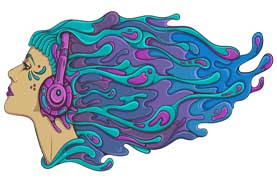
Users of psychedelic substances, from traditional shamans to modern-day therapy patients and recreational users, have often reported ESP experiences occurring in the drug-state.
Parapsychologists, keen to discover whether this altered state of consciousness might prove a reliable way to induce clairvoyance and telepathy, carried out a number surveys and experimental studies before the 1960s, when such research was brought to an end by the virtual global ban on psychedelics.
However, the restrictions on such research are gradually easing, opening a prospect of the relationship between psi and psychedelics being better understood.
Definition
According to Grinspoon and Bakalar, a psychedelic substance is 'one which, without causing physical addiction, craving, major physiological disturbances, delirium, disorientation, or amnesia, more or less reliably produces thought, mood, and perceptual changes otherwise rarely experienced except in dreams, contemplative and religious exaltation, flashes of vivid involuntary memory, and acute psychoses.'1
Field Reports of Intentional and Spontaneous Psi Phenomena
Archaeological evidence suggests psychoactive plants have been ingested the world over for millennia,2 and there are many examples in the literature of anthropology and ethnobotany of this leading to the appearance of ostensible psi phenomena3 - despite reservations on the part of anthropologists against reporting them.4 Reports of paranormal experiences in this context became more frequent following the discovery of psychedelic compounds by the academic community, and their popularization by the novelist Aldous Huxley5 and others. This attracted the attention of parapsychologists, who embarked on research of psi in relation to psychedelics, primarily from the 1950s and 1960s6. JB Rhine, the founder of parapsychology as an experimental science, ran informal psychedelic sessions in 1961 in collaboration with the then Harvard psychologists Timothy Leary and Richard Alpert,7 although the sessions apparently generated too much spontaneous laughter for anyone to credibly test for anything.8
Several other parapsychologists have reported personal ESP experiences with the use of psychedelics.9 Krippner’s apparent precognitive vision of President Kennedy’s assassination while on psilocybin a year before serves as an example.10 Similar reports of ESP being experienced by consciousness researchers, chemists, anthropologists and psychonauts can also be found elsewhere in the literature.11
There are surprisingly few published psychiatric inpatient reports relating to psychedelics and paranormal experience.12 This may be due to the lack of spontaneous phenomena within the psychiatric population, or to the medicalization within psychiatry of paranormal experiences as ‘delusions’ or ‘hallucinations’. Indeed, Mogar noted that early psychoanalytic and behaviourist researchers using LSD were prejudiced against ESP phenomena.13 Yet one study, a psychiatric-interview survey with users of LSD, 14 reported precognitive experiences as one of the symptoms of the LSD flashback phenomena, now referred to as ‘hallucinogen persisting perception disorder’.15
On the other hand, many accounts of paranormal experiences with psychoactive drugs can be found in the field of psychedelic-assisted psychotherapy, from therapists who write about their work in detail, and these tend to occur with greater frequency than in non-psychedelic therapy16. The psychiatrist Stanislav Grof – who is generally credited with the greatest expertise in this field, having conducted more than 4,000 psychedelic therapy sessions over a two decade period – claimed to have observed patients experiencing ESP - particularly precognition and accurate remote viewing – on a daily basis. 17 18 The occurrence of extraordinary coincidences, or synchronicities, was the most frequent type of experience but, curiously, these occurred only among those clients who experienced transpersonal breakthroughs within the psychedelic session.19
A wealth of reports attests to the spontaneous occurrence of ostensible psi phenomena with the use of psychedelic substances, but such experiences are not necessarily genuine psi events. Aside from the usual arguments for and against spontaneous phenomena as evidence for the paranormal,20 21 the fact that respondents had consumed a vision-inducing substance may be considered reason to question the accuracy of their perception and the interpretation of their experiences – at least for cases that are not substantiated by evidence or independent observers. Nevertheless, Shanon22 pointed out that the usual definitions of hallucination in the psychological literature fail to adequately encompass the diverse and complex nature of experiences that occur with psychedelics, nor can assumptions be made about the ontology (the reality) of such psychedelic-induced visions. Indeed, it is common for people who have had ostensibly paranormal psychedelic experiences to emphasise how real they felt, more real even than ordinary waking experience.23Empirical research is needed to validate these claims.
Surveys of Paranormal Belief and Experience in Relation to Drug Use
Two trends can quickly be perceived in the research. First, virtually all of the 16 surveys reviewed were published since the 1970s, following the ban on the use of psychoactive drugs that led to an end to research with humans (although this research is now slowly resuming). Second, most of the surveys primarily focused on paranormal experiences (nine surveys) and/or belief (seven surveys); they also tended to record drug use information as one of many possible co-variables (ten surveys), often omitting to distinguish among the different substances. Only six studies specifically approached users of psychoactive substances as the target sample.24
The findings from the survey research indicate a small but consistent - and typically significant - relationship (r = .16 to .25) between paranormal belief and drug use, although its size was more pronounced among marijuana users in one study.25 Furthermore, these studies support the hypothesis that psychedelics can induce some paranormal experiences, although the arguments that are advanced for and against the genuineness of field reports also prevail here. 26 Of the reviewed surveys, correlations between the occurrence of paranormal experiences (including psi and mystical experiences) and the use of all drugs (excluding prescription drugs) ranged from r = .13 to .46, and were typically significant. In addition, or alternatively, those reporting ESP and anomalous or paranormal experiences were found to be significantly more likely to use psychedelics. One study recorded the same finding for recurrent spontaneous psychokinesis (also known as poltergeist phenomena), although only tentatively.27
Of those reporting the use of psychedelics, between 18-83% reported ESP experiences – most commonly telepathy but also precognition – actually occurring during drug use, with heavier users reporting more experiences where specified. Yet, conversely, the occurrence of psychokinesis during drug use was only reported to occur by between 13-22% of those using psychedelics.28
Where specified, the relationship with paranormal experiences, belief in the paranormal, transliminality, and tolerance of ambiguity is much reduced with cocaine, heroin, and alcohol, compared to psychedelics, perhaps reflecting Metzner’s classification of these former substances as consciousness-contracting drugs.29The same is also true for the negative relationship with the fear of psi and use of psychedelics, which is not apparent with heroin and actually reversed with alcohol, although replication and analyses for specific classes of drugs is needed to confirm this.30
Correlations between self-reports of cannabis use and ‘thought transmission’ in psychiatric research are apparent, often indirectly, though telepathy experiences are also more widely reported in the apparent absence of pathology, with or without cannabis. Most of the surveys failed to adequately identify which substances lead to which experiences, although a switch to such taxonomic research is now evident. 31Substances particularly favourable to the experience of telepathy were found to be cannabis, MDMA and DXM. No one substance was particularly generative of precognitive experiences, and possible candidates for clairvoyance were cannabis, LSD, and psilocybin. As yet no research has explored both state and trait personality dimensions in relation to substance-induced psi experiences, although such research is encouraged.32 33
Experimental Psi Research with Psychedelics
The earliest parapsychology experiments with psychoactive substances, published between 1943 and 1961, were conducted with simple stimulants and depressants such as caffeine, amphetamine, alcohol, amytal, and quinal-barbitone, with mixed results.34
Table summarising all controlled experiments into ESP with psychedelics

* Study reports that participants were experienced with psychedelics
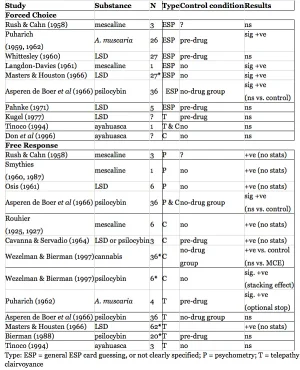
* Study reports that participants were experienced with psychedelics
So far there have been only 18 published papers, comprising 23 separate experiments, into the efficacy of psychedelics for inducing ESP, primarily with LSD or psilocybin, but also with mescaline, cannabis, Amanita muscaria, and ayahuasca (for a summary see Table 1). The results of these experiments, which began in the 1950s, varied in their degree of success, most likely in relation to the methodology involved.35 The most successful experiments tended to utilize participants who were experienced in the use of psychedelics, and also utilized free-response testing procedures, with open-ended mentation regarding their internal state rather than forced-choice guessing scenarios, which tend to be repetitive and thus rather boring, especially in the drug-induced state. Indeed, Luke36 suggests that the more naïvely-designed projects lost any hope of sensibly testing for anything, let alone psi, once their inexperienced participants succumbed to the mystical rapture of their first trip.
These few experiments were also reported quite differently, sometimes as entire monographs in excess of a hundred pages, at other times as footnotes within another published report, often lacking useful details and statistics. The majority were essentially pilot studies, mostly conducted during the psychedelic research period of the 1960s.
Due to the exploratory nature of most of these experiments, it is difficult to fully assess their efficacy in using psychedelics to produce ESP (no psychokinesis experiments having been attempted). In most cases the study could have largely been improved with an adequate control condition for order effects,37 also the masked use of decoy targets in the judging process. Procedures using subjective probability estimates by experimenters (such as Asperen de Boer, Barkema, & Kappers38) are now virtually obsolete in parapsychology, being difficult to assess and prone to bias.39 Of 10 ESP-card experiments, in the one that used a control condition the scores in the psilocybin condition were significantly different from chance and were also superior to the control condition, although not significantly.40 Nevertheless, experiments using forced choice ESP-card type symbol guessing procedures were largely unsuccessful compared to chance expectation. Indeed, the use of the symbol-guessing procedure has been widely criticized for being far too mundane under the influence of psychedelics.41 Even so, using Amanita muscaria, Puharich42 showed that forced-choice procedures could be successful with picture-sorting tasks, although there are concerns that Puharich’s experiments were not well controlled for possible sensory leakage.
Alternatively, more engaging, free-response procedures have demonstrated at least some success in all but one of the four studies that used psychometry – the supposed ability of psychically determining the provenance of a given object – although rarely with any control condition for comparison. A clearer indication of possible psychedelic-induced ESP, at times in comparison to a control condition, comes from the four clairvoyance and four telepathy designs, which were mostly positive.43 Despite some promising trends, however, replication is needed and, in most cases, with better methodology and pre-planned analyses. It remains curious that no formal experiments with precognition or psychokinesis have been carried out, particularly the former, considering that powers of divination are traditionally attributed to many plant psychedelics.
Methodological Critique of the Experimental Research and Suggestions for Future Study
When consideration is given to what has been learned from these largely pilot studies, experimenters and commentators alike have highlighted the difficulties involved in attempting to test for psi with participants who have taken a psychedelic. Asperen de Boer et al.44 suggested that participants’ willingness to perform in the task was important, but given the difficulty of maintaining alertness, self-control, focus, interest and orientation to the task,45 46 equal or more importance should be given to the participants’ capability of performing in the experiment, rather than mere willingness.47
Parker48 notes that a participant’s increased sensitivity to subtle influences under psychedelics is both a boon and a bane to research. Luke49 points out that the qualities that make such research alluring also make for poor test participants, as they may become engrossed in one or more aspects of the experience - the aesthetic rapture,50 51 the quest for philosophical knowledge,52 soul-searching self-examination,53 their personal drama54 55 - or simply in observing the flow of their thoughts.56 In addition, participants may struggle to find adequate ways to describe57 the overwhelming flood of ideas and emotions,58 and the speed of change of the internal experience.59 60 The experience of dissociation (for instance with ketamine) can also hinder communication when participants are no longer present or aware of their physical environment, and, as Huxley61 notes, there is a need to reassure participants of their very identity once constructs of space and time disappear.
Despite such drawbacks, it is apparent that obstacles to research may be alleviated or even eliminated if participants in research are experienced in the use of psychedelics.62 63 64 Indeed, about a quarter of inexperienced participants are expected to have intense spontaneous mystical experiences during their first trip.65 Only three of the 19 studies66 67 68 specifically reported the use of experienced participants, and these were relatively more successful at getting above-chance psi scores than those that used inexperienced participants.69 Further, it has been suggested that experienced participants can be trained more easily to stabilize their experience70 71 and may even train themselves to achieve this naturally through repeated use.72 Regardless of training, it has been strongly advised that participants be allowed to stabilize their experience before testing begins.73 74 75 76 Pahnke77 further recommended an eight to twelve hour pre-dose preparation period when working with terminal cancer patients, although Ludwig78 questioned the necessity of this in a parapsychological context.
Stabilization of the experience may even be expedited by inducing hypnosis prior to drug administration7980 in what has been called the ‘hypnodelic’ state.81 Alternatively, Ryzl82 reported re-inducing LSD states through hypnosis, as is also reported elsewhere; it was uncertain how successful this was,83 though success inducing other drug states (such as MDMA and heroin) has been reported.84 85 It may be that the entire range of psychedelic experiences can be hypnotically re-induced in experienced users, so that no psychedelics need actually be taken during the test procedure. Testing for psi under such ‘controlled flashbacks’ may overcome most of the stipulated problems, with the added advantage of investigating Rogo’s86 question of whether psi should be attributed to the neurochemical action of the drugs or the state induced thereby. Nevertheless, this approach somewhat restricts participants to those who are both experienced and comfortable with psychedelics and are also highly suggestible.
Some researchers87 88 suggest that scores in drug studies would improve with the use of psychics and mediums. However, the famous medium Eileen Garrett89 noted that, while LSD enhanced her mediumistic experience, it did not improve her forced choice test-scores. Echoing this, Osis90 found that mediums were no more successful than normal participants in the other psychometry experiments. This may be explained by the problems associated with inexperienced psychedelic users, indicating that sample selection should primarily seek to identify experienced users in preference to psi-effective participants, although presumably, ideal participants would be both. It is also noted that in traditional shamanic cultures mediumship and the use of psychedelics are rarely found together.91
Considering aspects of timing, several authors have offered advice, though no formal studies have been conducted. Both Ryzl92 and Grof93 suggested that the optimum period for testing psi with LSD was towards the end of the session, when the effects were levelling off – as in the Masters and Houston94 experiments. However Pahnke95 disagreed. As regards to the duration of the psi-task, in preference to the extended test periods favoured by some researchers,96 97 Osis98 suggested twenty minutes as the maximum for optimum performance.
Some consideration has also been given to the optimal substance. Pahnke99 recommended combining stimulants with psychedelics, whereas Asperen de Boer et al.100 preferred psilocybin to LSD, due to it being milder; Cavanna and Servadio101 agreed. Indeed, LSD has a much longer duration of action than psilocybin and as Blewett102 noted, ten-hour trips are hard to staff. Ryzl103 also questioned the utility of LSD in psychedelic psi testing; he proposed that the ideal substance, if it can be synthesized, should inhibit cortical activity to suppress the stream of thoughts, depress sub-cortical activity to block incoming stimuli, and excite spheres of the cortex involved in ESP production, while maintaining rational insight and increasing suggestibility. Such a designer drug is far in the future, however. Meanwhile, previously unfamiliar ethnobotanical substances are becoming known that have traditionally been used for psychic purposes, but which have not yet been thoroughly tested, or even tested at all, for instance Salvia divinorum.104
Tart105 has further suggested that marijuana is an ideal substance for psi experimentation because of its wide familiarity, its mild psychedelic qualities, and its reputed ability to induce psi, experientially at least. Puharich’s106 apparent repeated success with Amanita muscaria also needs replicating. Other, non-psychedelic chemical psi research, such as Pablos’s107 unsuccessful first-person precognitive-dream drug-study, could also be replicated with the use of psychedelic substances that have been reported to induce psi in dreams, such as the ostensibly precognitive dreams described by both traditional users and by modern consciousness researchers in relation to substances such as Calea zacatechichi,108 109 Silene capensis,110111 and tree datura (Brugmansia).112
Telepathy-like experiments might also benefit from the empathogenic effect of substances such as MDMA: the single participant who was placed under its influence in a remote detection experiment did exceedingly well113, and reports of telepathy are typical with this substance.114 Group telepathy with people under the influence of DXM has also been independently reported by numerous survey respondents.115 The use of a placebo in a double-masked or masked control condition, as in Cavanna and Servadio,116 is of questionable utility in this type of experiment, because at anything less than sub-threshold doses the participant is likely to easily detect the effects of the drug; nevertheless, researchers should be aware that placebo drug effects have been demonstrated in ESP research, when coupled with positive false feedback on task performance.117One way in which researchers have attempted to circumnavigate the poor disguise of psychedelics, and reduce expectancy effects, in non-parapsychological research is to tell the participant in advance that they may receive a placebo or one of a number of different drugs, only one of which is a psychedelic, though ultimately participants can usually tell when they get a psychedelic dose.
Several researchers have also commented on the importance of dosage.118 Indeed, Blewett119 warned that giving participants low doses of LSD may not be sufficient to break through the barrier between the normal and the full-blown psychedelic state, and as a result be merely disorientating rather than transformative. Support for this logic is also evident in escalating dose research with DMT.120 It is additionally advised that experienced participants control their own dosage,121 as in the experiment by Wezelman and Bierman.122Participants’ self-reports of the depth of the altered state were considered better than dosages as indicators of subjective effects.123 Self-reports using the Hallucinogenic Rating Scale were seen to be more accurate indicators of dosage than physiological measures,124 though the use of a scale of transpersonal experience, such as the Self-Expansiveness Scale Form,125 would also likely be fruitful in discerning the relevant depth of the psychedelic state of consciousness. Furthermore, some researchers,126 127 have noted that the issue of dosage is largely irrelevant in comparison to the influence of the psychological factors of set and setting, as originally noted in psychedelic research by Leary, Litwin, and Metzner.128 In discussion of this, Vayne129suggested that the influence of psychological factors on psychoactive drugs can vary their effects so much that the drug can be thought of primarily as an experience, composed of set, setting, and substance.
Factors considered important in determining psychological set include the participants’ expectations, their attitudes towards themselves, their idiosyncratic perceptions, and their emotional orientation to the experiment.130 131 It is also deemed imperative to engender a sense of self-surrender, acceptance, and trust.132 Factors considered important in determining psychological setting include those that are ordinarily considered under demand characteristics,133 134 particularly the experimenter’s attitude, which should be warm, friendly, and supportive.135 Psychological issues induced through interpersonal relations within the laboratory become magnified when participants are on psychedelics.136 137 Indeed, Cavanna and Servadio138 highlighted this when one of their participants had an anxiety attack concurrent with their own anxiety, which led them to advise that experimenters themselves should be experienced users of the substance under investigation, as echoed by Strassman.139
Tart140 also recommended that the experimenter should guide the experience towards the goal of the study, and criticized previous work that assumed psychedelic states will automatically induce psi: as noted by Tart, Osmond, and Beloff,141 in traditional scenarios, the shamans who use these substances usually have extensive training and experience. It is further suggested that the experimental task be shaped to the state of the participant, not vice versa,142 and utilize the strong motivation, directed awareness, and complex ritual that is found in shamanism.143 144 Grob and Harman145 have also urged the integration of aspects from shamanic practices into scientific procedure, with attention being directed to factors of set and setting such as intention, expectation, preparation, group identification, and formalized structure, as well as the integration of the experience in the following months. Indeed, a multi-method approach to studying psychedelic shamanic practices is advised, so that ethnography can inform suitable experimentation.146 147
Nevertheless, Storm and Rock148 pointed out that, in psi research with psychedelics, researchers need to be aware of the difference between shamanic techniques and merely shamanic-like techniques; for example, the latter may lack the purpose of serving one’s community. Tart149 recommended the implementation of mutual research, where participants are considered as co-investigators, as a means to reduce experimenter bias and enhance a sense of participation, trust, and motivation. One way to ensure such congenial factors in the experimental setting may be to have an experienced psychedelic user and parapsychologist as both the experimenter and participant,150 concerns over placebo effects notwithstanding.
Overview of Psychedelic Psi Research
Even though the subjective paranormal experiences, clinical observations and anthropological reports are subject to all the usual criticisms and rebuttals that apply to non-experimental cases151 there is a growing body of reports, rooted in thousands of years of traditional psychedelic use, that supports the notion that genuine psi phenomena do occur in psychedelic states. As evidence these data are not scientifically rigorous, but they have great value in mapping the phenomenological terrain of psi experiences with psychedelics. This body of reports is further supported by correlations from surveys linking psychedelic use with the increased reporting of psi experiences and belief in psi and the paranormal, although self-reports have more phenomenological merit than evidential value. Furthermore, even though it can be considered little more than exploratory at this stage, the experimental evidence is mostly positive and proves promising so far, illuminating both methodological pitfalls and possibilities.
It is apparent that parapsychopharmacology is a multidisciplinary endeavour, pooling expertise from anthropology, ethnobotany, phytochemistry, neurobiology, psychopharmacology, psychiatry, psychotherapy, transpersonal psychology, and indeed parapsychology. It also owes much to the non-academic explorers of consciousness, be they shamans, occultists, or psychonauts. This branch of research is still very much in its infancy, and, along with other fields conducting research with the use of psychedelics, has been operating very quietly since the late sixties, until a gentle turn in the tide during the last twenty years or so has seen experimental research resumed.152 Nevertheless, experimental research continues to be constrained by requirements for strict ethical and often governmental approval before it can proceed, requiring lengthy applications.153 154
Tart155 recommended bypassing these difficulties by casually enrolling participants who were already using psychedelics, rather than having the experimenter administer the substances directly. An example of this kind of experiment involved several thousand Grateful Dead fans, renowned for their psychedelic consumption, who acted as senders in a series of dream telepathy experiments, with some success.156Indeed, taking what Giesler157 calls a psi-in-process approach, and keeping naturalistic variables intact, group experiments may be one way to access the kind of group telepathy experiences that people tripping in groups sometimes report,158 especially on DXM.159 However, without the grounded and controlled atmosphere of a concert or shamanic ceremony, psychedelic group ESP experiments run the risk of turning into bacchanalian scenes, as reported in Puharich’s experiments by his wife.160
Ideally, direct parapsychological research with psychedelics would expand beyond those countries that have legal access to such substances, such as the Netherlands and Brazil – the latter being the only place where experimental psychedelic parapsychology research has been conducted since the 1970s. Furthermore, treating these substances like any other drug worthy of investigation within a medical or therapeutic context has recently proven a fruitful means of inquiry for many researchers,161 although psi research does not readily attract such funding at the present time. Nevertheless, it should be noted that psychedelics are considered as sacramentals by the spiritual and religious groups that use them and they must be utilized and researched with respect.
Luke162 suggests that, besides trying to replicate promising free-response studies, experimental psychedelic research in the future should utilize protocols that maximize psi effects. This work can then simultaneously enhance process research methodology, by indicating optimal conditions for psi through the psychologically magnifying effects of these substances. For instance, Bierman’s163 psychedelic psi research may have revealed the apparent psychic blocking of negative images, and from earlier experiments, that forced-choice tasks are clearly too mundane. Research should also seek to study these substances in the shamanic context, in which they have most effectively been used, designing appropriate test protocols for traditional settings.
Following in the footsteps of William James, Pablos returned to self-experimentation,164 developing a viable protocol for self-testing precognitive dreaming abilities with drugs, that might be adapted to waking experimentation as well. Experimental research should also be designed and conducted with an appreciative consideration of Tart’s proposals for the creation of state-specific sciences.165 Finally, as ever greater numbers of substances are discovered, and with a correspondingly large natural participant pool of psychedelic users, there is a need for more thorough and focused phenomenological research, that investigates and identifies the various types of paranormal experience that may occur in relation to each.166
David Luke
(References available upon request - all 166!)
I don't alway get my notificationsOh god Sandie I’m sorry to hear of her passing!
I hope it was fast for her and she wasn’t in much pain.
I can totally understand getting out and doing something like that to process emotions and whatnot, I’m glad that you have a good outlet and outlook an the whole thing.
As natural as it is, it is still sad to see someone go if only for the reason that they cannot share their voice and light with us for a time.
But yes...I see death in much the same way...if not the same way.
Let me know if you wanna talk more about....PM me if you need!
Hmmmm?
Bail money?
No way!
It will be decriminalized here in a heartbeat now that Denver AND Oakland have done it...Portland will and WA will follow.
Hell...it’s funny but some of the most hallucinogenic mushrooms you can find grow in nearly every public park in Portland at certain times of the year.
There are already people who serve as “guides”, and people pay them a crap ton of money too.
I would feel badly taking someone’s money for something of which I feel so strongly about the healing abilities.
Hence the rest of the services - you are basically paying for the other services while the mushrooms would technically be free the way I see it.
There is probably some good legal loophole there hahaha!
And that way...services can be a la cart...for those who cannot afford the whole package.
Much love to you and your family Sandie....may your weekend be peaceful and I hope there and not too many tears.
You know where to find me.

Perhaps it's because I needed to read your kind words today @Skarekrow ❤ thank you!
No worries for now, I know where you're at
JennyDaniella
Stargazer
- MBTI
- INFJ
- Enneagram
- 925
BritNi
Perceptive Optimist
- MBTI
- INFJ
- Enneagram
- 2w1
Hell yeah! This is cause to celebrate!Oooohhh....page 444!

Break out the champagne!
Seriously though, it's very impressive. How many pages do you get before you max out? Plus a repeating triple digit... That's fun!
---------------------
I know this was intended for play, but it got my wheels spinning because of its truth.
We have no control over much of what we learn. Our behaviors, cultural practices, beliefs, etc. are some things, for example, that are ingrained in our memory by our caregivers and such. From the time we are born, we absorb much information, but not all of it is true. It's truly limiting. Often, our learned behaviors and thought processes are counteractive to our own mental health, well being, and personal growth among other things.
Basically, for reasons out of our control, our growth is stunted as far as prospering and becoming the best version of ourselves.
Brainwash. That's what it is.
It's my mind, why do others have the power to taint it?
By the time we become aware of the negative learned behaviors (not everyone gets to that point), should we desire change, we must unlearn past behaviors And replace them with the new.
But years upon years of conditioned thoughts, behaviors, and beliefs is not easy to erase. It takes much effort; it can be exhausting.
Basically, my heart goes out to the guy in the picture. May he unlearn everything his pretty heart desires. =)
I understand the other perspectives on the matter as well, but I'm just speaking on this perspective for now.
Thanks for listening.
.
1. “The first problem for all of us, men and women, is not to learn, but to unlearn.” Gloria Steinem
2. “The most useful piece of learning for the uses of life is to unlearn what is untrue.” Antisthenes
3. “Half of wisdom is learning what to unlearn.” Larry Niven
4. “Transformation is often more about unlearning than learning.” Richard Rohr
5. “You must unlearn what you have been programmed to believe since birth. That software no longer serves you if you want to live in a world where all things are possible.” Jacqueline E. Purcell
6. “The illiterate of the future are not those who can’t read or write but those who cannot learn, unlearn, and relearn.” Alvin Toffler
7. “When any real progress is made, we unlearn and learn anew what we thought we knew before.” Henry David Thoreau
8. “A good deal of education consists of unlearning – the breaking of bad habits.” Mary McCarthy
More at this random website which I didn't check for credibility. Lol. It's just for fun.
https://www.awakenthegreatnesswithin.com/35-inspirational-quotes-on-unlearning/
1. “The first problem for all of us, men and women, is not to learn, but to unlearn.” Gloria Steinem
2. “The most useful piece of learning for the uses of life is to unlearn what is untrue.” Antisthenes
3. “Half of wisdom is learning what to unlearn.” Larry Niven
4. “Transformation is often more about unlearning than learning.” Richard Rohr
5. “You must unlearn what you have been programmed to believe since birth. That software no longer serves you if you want to live in a world where all things are possible.” Jacqueline E. Purcell
6. “The illiterate of the future are not those who can’t read or write but those who cannot learn, unlearn, and relearn.” Alvin Toffler
7. “When any real progress is made, we unlearn and learn anew what we thought we knew before.” Henry David Thoreau
8. “A good deal of education consists of unlearning – the breaking of bad habits.” Mary McCarthy
More at this random website which I didn't check for credibility. Lol. It's just for fun.
https://www.awakenthegreatnesswithin.com/35-inspirational-quotes-on-unlearning/
Also: when I refer to we, I mean everyone. A society of people. Not just you and I think that's clear, but just to be sure...
Last edited:
Skarekrow
~~DEVIL~~
- MBTI
- Ni-INFJ-A
- Enneagram
- Warlock
Hell yeah! This is cause to celebrate!
Break out the champagne!
Seriously though, it's very impressive. How many pages do you get before you max out? Plus a repeating triple digit... That's fun!
---------------------

I know this was intended for play, but it got my wheels spinning because of its truth.
We have no control over much of what we learn. Our behaviors, cultural practices, beliefs, etc. are some things, for example, that are ingrained in our memory by our caregivers and such. From the time we are born, we absorb much information, but not all of it is true. It's truly limiting. Often, our learned behaviors and thought processes are counteractive to our own mental health, well being, and personal growth among other things.
Basically, for reasons out of our control, our growth is stunted as far as prospering and becoming the best version of ourselves.
Brainwash. That's what it is.
It's my mind, why do others have the power to taint it?
By the time we become aware of the negative learned behaviors (not everyone gets to that point), should we desire change, we must unlearn past behaviors And replace them with the new.
But years upon years of conditioned thoughts, behaviors, and beliefs is not easy to erase. It takes much effort; it can be exhausting.
Basically, my heart goes out to the guy in the picture. May he unlearn everything his pretty heart desires. =)
I understand the other perspectives on the matter as well, but I'm just speaking on this perspective for now.
Thanks for listening.
.
1. “The first problem for all of us, men and women, is not to learn, but to unlearn.” Gloria Steinem
2. “The most useful piece of learning for the uses of life is to unlearn what is untrue.” Antisthenes
3. “Half of wisdom is learning what to unlearn.” Larry Niven
4. “Transformation is often more about unlearning than learning.” Richard Rohr
5. “You must unlearn what you have been programmed to believe since birth. That software no longer serves you if you want to live in a world where all things are possible.” Jacqueline E. Purcell
6. “The illiterate of the future are not those who can’t read or write but those who cannot learn, unlearn, and relearn.” Alvin Toffler
7. “When any real progress is made, we unlearn and learn anew what we thought we knew before.” Henry David Thoreau
8. “A good deal of education consists of unlearning – the breaking of bad habits.” Mary McCarthy
More at this random website which I didn't check for credibility. Lol. It's just for fun.
https://www.awakenthegreatnesswithin.com/35-inspirational-quotes-on-unlearning/
Thanks!
Those are very true and wise words both from you and in the quotes!
Yes, it’s very true...our own expectations account for a lot of how we behave when faced with certain hurdles.
One of the techniques for mindfulness is called “beginner’s mind” or Shoshin :
Shoshin (初心) is a word from Zen Buddhism meaning "beginner's mind." It refers to having an attitude of openness, eagerness, and lack of preconceptions when studying a subject, even when studying at an advanced level, just as a beginner would.
https://en.wikipedia.org/wiki/Shoshin
They now understand that our body anticipates certain things and reacts based on past experience and not necessarily the reality of the situation.
Just thinking about standing up increases your blood pressure in anticipation of needing blood flow to the head to be sustained.
The same can also backfire into your brain creating something that is not there via this route.
If you think it will hurt when you do this or that - then it most likely will.
If you are used to your back hurting when you bend over, then your brain can anticipate the pain and create the signal even before it has been registered.
This all gets hard-wired in of course and is no longer very much in our control after that.
The name of the game is neuroplasticity.
You cannot keep your mind flexible if you cannot unlearn that response...the same goes with everything we have learned.
Thanks again for your input!
Take care and much love!

Last edited:
BritNi
Perceptive Optimist
- MBTI
- INFJ
- Enneagram
- 2w1
I actually do practice this! And I encourage others as well. I mostly encourage it within a psychosocial perspective. When we meet someone new, it's best to practice Shoshin, imo. Leave all stereotypes and prejudices unconscious. Learn everyone from the beginning. Strive to be as open as possible.One of the techniques for mindfulness is called “beginner’s mind” or Shoshin :
Shoshin (初心) is a word from Zen Buddhism meaning "beginner's mind." It refers to having an attitude of openness, eagerness, and lack of preconceptions when studying a subject, even when studying at an advanced level, just as a beginner would.
Thanks for having me. =)
Much love in return.
John K
Donor
- MBTI
- INFJ
- Enneagram
- 5W4 549
@Skarekrow @BritNi
One of the few advantages of growing old is that I forget what I used to know. There must be heaps of the stuff lying around rotting somewhere, but it doesn't seem to make any difference - life goes on just the same lol.
One of the few advantages of growing old is that I forget what I used to know. There must be heaps of the stuff lying around rotting somewhere, but it doesn't seem to make any difference - life goes on just the same lol.
Skarekrow
~~DEVIL~~
- MBTI
- Ni-INFJ-A
- Enneagram
- Warlock
@Skarekrow @BritNi
One of the few advantages of growing old is that I forget what I used to know. There must be heaps of the stuff lying around rotting somewhere, but it doesn't seem to make any difference - life goes on just the same lol.
This is so true!
lol
“One of the keys to happiness is a bad memory.”
~ Rita Mae Brown
Hope you are doing well my friend!

- MBTI
- INFJ
- Enneagram
- 954 so/sx
Shoshin
Good word
- MBTI
- INFJ
- Enneagram
- 954 so/sx
BritNi
Perceptive Optimist
- MBTI
- INFJ
- Enneagram
- 2w1
- MBTI
- INFJ
- Enneagram
- 954 so/sx
Fo' shoshin.
Lol
Lmaooo ^_^
John K
Donor
- MBTI
- INFJ
- Enneagram
- 5W4 549
This is so true!
lol
“One of the keys to happiness is a bad memory.”
~ Rita Mae Brown
Hope you are doing well my friend!

This is very true too

I was doing pretty well till I watched Wy's gif just now

Skarekrow
~~DEVIL~~
- MBTI
- Ni-INFJ-A
- Enneagram
- Warlock
I was doing pretty well till I watched Wy's gif just now
She needs an athletic cup!
LMAO
Skarekrow
~~DEVIL~~
- MBTI
- Ni-INFJ-A
- Enneagram
- Warlock
Current source of reading material:
The Science and Practice of Humility: The Path to Ultimate Freedom
Bought last month at Powells in Portland when @Tin Man and @Kgal were visiting me and @Sensiko !
Have read about a third of it so far and am really enjoying it.
Probably one of the most knowledgable books I’ve read in regards to the practice and history of this concept.
I highly recommend it, but maybe not for someone without at least a little knowledge into the ideas presented.
Much love and cheers!
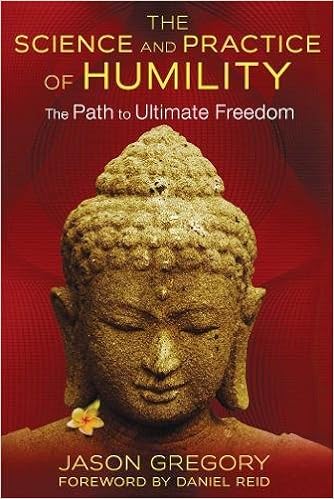
Humility, being open and receptive to all experience, is the key to becoming one with the spontaneous patterns of the universe
• Integrates classic teachings of Hinduism and Buddhism with principles of quantum physics to reveal the science of the enlightened masters
• Reveals how we are each capable of shifting from the aggressive path of the warrior to the humble path of the sage
• Explains how the key to catching the current acceleration of conscious evolution is humility
From Krishna and Lao-tzu to Buddha and Jesus, each enlightened master discovered how being receptive to all experience was the key to becoming one with the universe and its spontaneous patterns of order and chaos.
Revealing humility as the purest expression of this receptivity, Jason Gregory integrates classic teachings of Hinduism, Buddhism, Taoism, and Hermeticism with principles from quantum physics to explain the science of humility as practiced by the ancient masters.
The author shows how, driven by fear, the human mind creates the ego.
In its greedy and arrogant quest to protect the self and its desires, the ego forges the illusion of separation, weaving complex patterns of reality that shield us from our unity with all beings and result in attitudes of aggression, selfishness, and competition.
He reveals how the iconic clash between this complex, aggressive “path of the warrior” and the simple “path of the sage” is reflected in the polarized state of the modern world.
Yet this state also reflects the accelerating wave of conscious evolution we are now experiencing.
The key to catching this evolutionary wave is humility: the reversal of complexity into simplicity, the ancient science of mental alchemy that represents the Great Work of Eternity.
Last edited:

